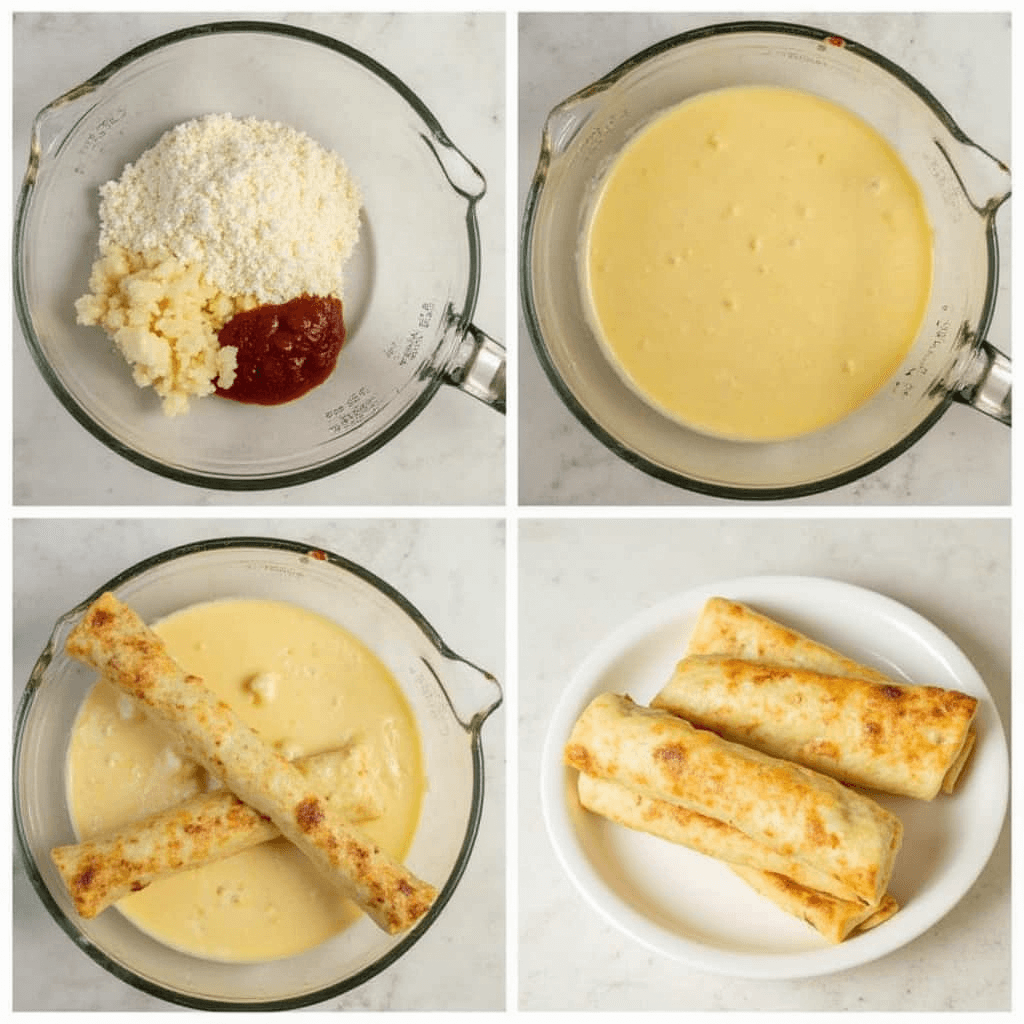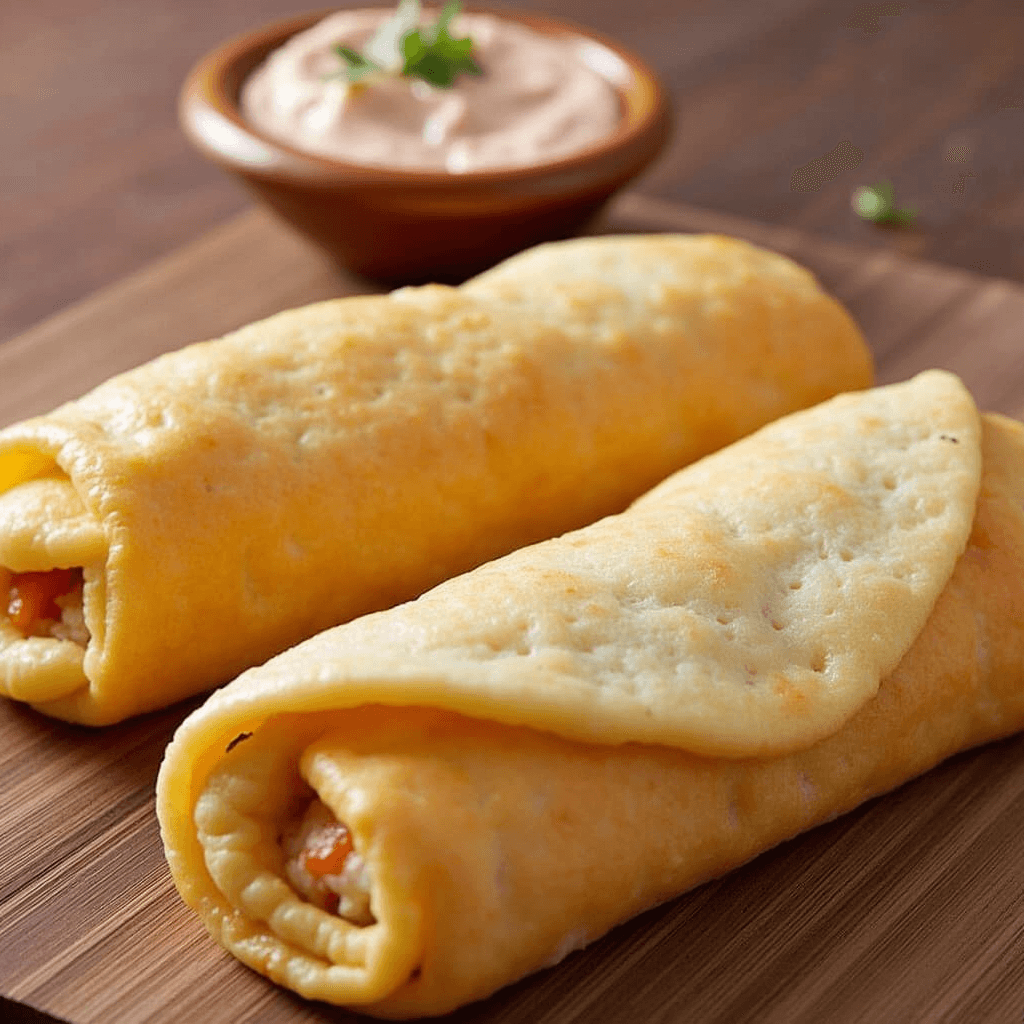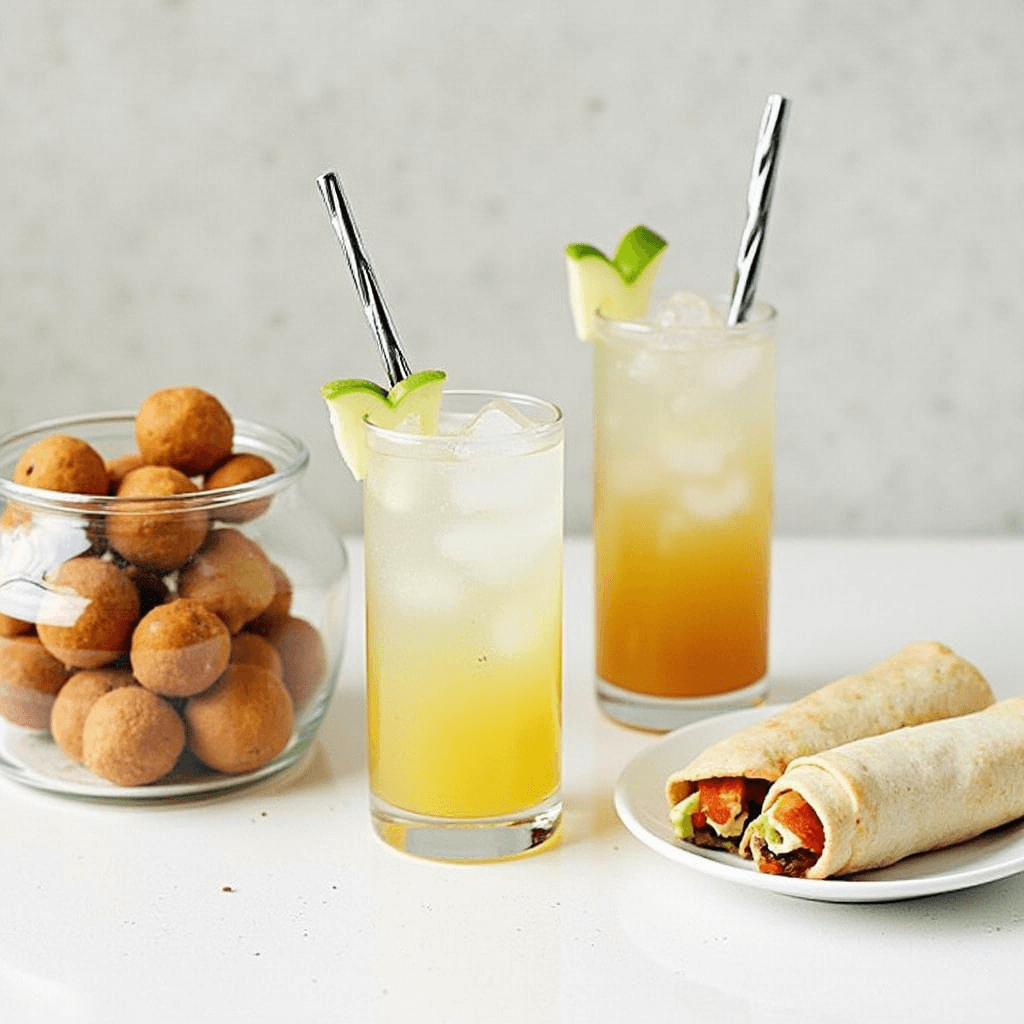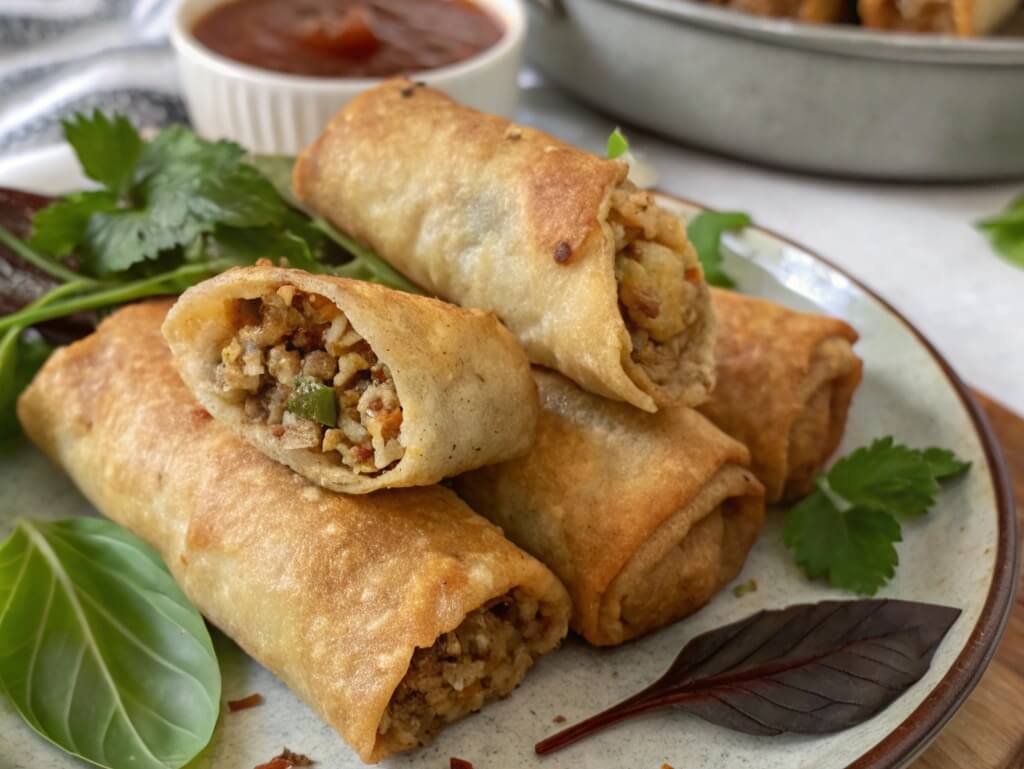Introduction
The Chiko Roll Recipe has been a staple in Australian cuisine for decades. Originally designed as a hearty, hand-held meal, this deep-fried snack quickly became a favorite. Unlike traditional spring rolls, it has a thicker wrapper and a more substantial filling. As a result, it offers a satisfying bite with a crispy exterior and a flavorful interior. This guide provides clear, structured steps to help you recreate this iconic dish at home. Furthermore, using the right techniques ensures your rolls achieve the perfect texture. If you are making it for the first time, focusing on the wrapping process is crucial. In addition, selecting fresh ingredients enhances the overall taste. With practice, you can refine your skills and perfect the recipe. Although Chiko Rolls are commonly found in takeaways, homemade versions allow for customization. Ultimately, mastering this recipe means enjoying an authentic Australian classic anytime.
Ingredients for Chiko Rolls
To make an authentic Chiko Roll Recipe, gather the following ingredients:
For:
the Filling:
- Finely shredded cabbage
- Carrot, grated
- Celery stalk, diced
- Small onion, finely chopped
- Cooked minced beef or lamb
- Cooked barley
- Salt and white pepper
- Worcestershire sauce
- Soy sauce
the Wrapper:
- All-purpose flour
- Cornstarch
- Salt
- Egg
- Water
- Vegetable oil
Frying:
- Vegetable oil
Essential Kitchen Tools
To successfully create this Chiko Roll Recipe, the following tools are necessary:
- Large mixing bowls for combining ingredients efficiently
- Whisk for smooth batter preparation
- Rolling pin to achieve even dough thickness
- Sharp knife for precise chopping of vegetables and meat
- Deep fryer or heavy-bottomed pan to ensure even frying
- Slotted spoon for safe handling and draining excess oil
- Paper towels to absorb excess oil and keep the rolls crispy
Additionally, a measuring cup helps maintain ingredient accuracy, while a pastry brush can assist in sealing the rolls properly. Using these tools contributes to an efficient and seamless cooking process, ensuring each roll maintains its structure, crispiness, and flavor. Proper preparation enhances the cooking experience and helps achieve the authentic taste and texture of a traditional Chiko Roll.
Step-by-Step Instructions
1: Prepare the Filling
- Heat a pan over medium heat and sauté onion, celery, and carrot until softened.
- Add minced beef, cabbage, barley, and seasonings. Stir thoroughly to blend the flavors.
- Cook the mixture for five minutes, then remove it from heat and allow it to cool.
2: Make the Wrapper
- In a bowl, mix flour, cornstarch, and salt.
- Gradually whisk in egg, water, and oil until a smooth batter forms.
- Let the batter rest for fifteen minutes to improve consistency.
3: Assemble the Chiko Rolls
- Roll out a thin wrapper on a floured surface.
- Place a portion of the filling in the center.
- Fold the sides over and roll tightly, sealing the edges with water.
4: Fry to Perfection
- Heat oil in a pan to 350°F (175°C).
- Fry rolls in batches for three to four minutes until golden brown.
- Drain on paper towels before serving.
How to Store and Reheat Chiko Rolls
Proper storage preserves the texture and flavor of your Chiko Roll Recipe. Once cooled, place rolls in an airtight container and refrigerate for up to three days. For longer storage, freeze them in a single layer before transferring to a freezer-safe bag. When reheating, use an oven or air fryer at 180°C (350°F) for 10–15 minutes to maintain crispiness. Avoid microwaving, as it can make the rolls soggy. If frozen, allow them to thaw slightly before reheating for even cooking. Proper storage and reheating techniques ensure your Chiko Rolls remain delicious and crispy for future enjoyment.
Reheating Instructions:
- Oven: Preheat to 350°F (175°C) and bake for 10-15 minutes.
- Air Fryer: Set to 375°F (190°C) and reheat for 5-7 minutes.
- Stovetop: Lightly pan-fry over medium heat for a crispy finish.
- Microwave: Use short bursts at 50% power, though this may soften the roll.
Following these steps ensures your Chiko Roll Recipe remains just as delicious as when freshly made.
Healthier Alternatives
A classic Chiko Roll Recipe can be adapted for a lighter version without sacrificing taste.
Health-Conscious Modifications:
- Baking Instead of Frying: Reduces oil content while maintaining crispiness.
- Whole Wheat Wrapper: Adds fiber for a healthier bite.
- Lean Protein Options: Swap beef for turkey or chicken.
- Increased Vegetables: Boosts nutrients with spinach, bell peppers, or mushrooms.
Making these changes allows you to enjoy a nutritious variation of the Chiko Roll Recipe without compromising flavor.
The Cultural Significance of Chiko Rolls

The Chiko Roll Recipe has a deep-rooted place in Australian food history. Originally inspired by Chinese spring rolls, it was designed as a convenient, hand-held meal. Introduced in the 1950s, it quickly became a staple at sporting events, fish and chip shops, and festivals. Its thick, doughy wrapper ensures a crispy texture, while the filling—a mix of beef, cabbage, carrots, barley, and seasonings—delivers a hearty, savory flavor. Over the years, its nostalgic appeal has kept it popular despite evolving food trends. Whether enjoyed as a quick snack or homemade for a personalized touch, the Chiko Roll remains an enduring Australian classic.
Why It Stands Out:
- Symbolizes Aussie street food culture.
- Nostalgic for generations who grew up enjoying them.
- A popular takeaway snack known nationwide.
Common Mistakes to Avoid
Mistakes can impact the success of your Chiko Roll Recipe. Avoid these pitfalls to achieve the perfect result:
- Overfilling the Wrapper: Leads to splitting during frying.
- Incorrect Oil Temperature: Too hot burns the roll; too cool results in greasiness.
- Skipping Rest Time for Dough: Weakens texture and structure.
- Using Low-Quality Ingredients: Fresh, high-quality vegetables and proteins enhance flavor.
- Improper Sealing: Causes leaks during frying.
By following best practices, your Chiko Roll Recipe will turn out perfectly crispy and flavorful every time.
Pairing Drinks with Chiko Rolls
Complementing the flavors of a Chiko Roll Recipe with the right beverage enhances the overall experience.

Best Drink Pairings:
- Classic Soft Drinks: Cola, lemonade, or ginger beer.
- Beer Selections: A crisp lager or pale ale balances the richness.
- Iced Tea: Refreshing and light, cutting through the fried texture.
- Fruit Juices: Apple or pineapple juice adds a sweet contrast.
- Sparkling Water: A simple, clean choice that refreshes the palate.
Homemade vs. Store-Bought Chiko Rolls
While pre-packaged options are convenient, making a Chiko Roll Recipe from scratch offers several advantages.
Homemade Benefits:
- Customizable Ingredients: Control flavors and avoid preservatives.
- Freshness Factor: No risk of stale or freezer-burned rolls.
- Healthier Alternatives: Adjust ingredients for dietary preferences.
Store-Bought Convenience:
- Quick and Easy: Requires no preparation.
- Consistent Taste: Familiar flavor every time.
- Readily Available: Found in most supermarkets.
Ultimately, a homemade Chiko Roll Recipe offers greater flexibility, while store-bought versions provide convenience.
Spring Roll Recipe
A classic spring roll recipe includes a filling of shredded vegetables like cabbage, carrots, and bean sprouts, sometimes with meat such as chicken or shrimp. The filling is seasoned with soy sauce, garlic, and ginger, then wrapped in a thin spring roll wrapper. The rolls are sealed with a cornstarch paste and deep-fried until golden brown. They are typically served with sweet chili sauce or a tangy dipping sauce. For a healthier version, spring rolls can be baked or air-fried. Fresh spring rolls, wrapped in rice paper, are a popular alternative, often served with peanut dipping sauce. Additionally, spring rolls can be customized by incorporating vermicelli noodles, mushrooms, or tofu for a vegetarian option. When frying, maintaining the correct oil temperature ensures an even, crispy texture. Whether made fresh or fried, these rolls are a flavorful and versatile appetizer that can be adapted to various tastes and dietary preferences.
Chiko Roll Australia
The Chiko Roll is an iconic Australian snack inspired by Chinese spring rolls but with a thicker, doughy wrapper. It was first created in 1951 by Frank McEncroe, designed as a portable meal for on-the-go eating. The filling consists of beef, cabbage, carrot, celery, barley, and spices, encased in a sturdy, deep-fried pastry shell. Traditionally sold at fish and chip shops, it became a staple at sporting events and takeaway outlets. Though its popularity has declined in recent years, it remains a nostalgic Australian fast-food item, still produced and enjoyed by many, especially for its unique taste and texture. The Chiko Roll’s resilience in Australian cuisine is due to its satisfying crunch and savory filling, making it a comforting and convenient snack. Some variations now offer healthier options, including air-fried or oven-baked versions, catering to modern dietary preferences while maintaining the traditional appeal.
Chiko Recipe
A homemade Chiko Roll recipe involves making a thick batter for the wrapper using flour, egg, and water. The filling consists of cooked beef mince, finely chopped cabbage, carrots, celery, barley, and seasonings such as salt, pepper, and Worcestershire sauce. The mixture is wrapped in the dough, rolled tightly, and sealed before being deep-fried until crispy. Some recipes use spring roll pastry for convenience. A homemade version allows for customization, such as using chicken instead of beef or adding extra vegetables. Pairing the roll with tomato sauce or a tangy dipping sauce enhances its traditional Australian flavor. For best results, ensure the oil is heated to the right temperature before frying, preventing excessive oil absorption. Additionally, resting the batter before use improves texture. Homemade Chiko Rolls allow for personal creativity, enabling cooks to experiment with different flavors while preserving the original taste and crispiness of this classic snack.
Chiko Chick
The term “Chiko Chick” refers to a marketing campaign by Chiko Rolls in Australia, featuring women promoting the product at events and advertisements. These models, often depicted in retro-styled posters, became an iconic part of the Chiko Roll brand. The campaign, popular in the 1970s and 1980s, reinforced the snack’s connection to Australian culture and fast food nostalgia. While the advertising approach has evolved over time, the Chiko Roll remains a well-known symbol of Australian takeout cuisine. Today, the brand focuses more on the product itself rather than the traditional promotional imagery of the Chiko Chick. Despite the shift in advertising, the Chiko Roll’s legacy continues, with new generations discovering its unique taste. The evolution of marketing strategies highlights how brands must adapt to changing consumer expectations while preserving the nostalgic appeal that makes their product a lasting part of Australia’s food history.
Egg Roll Pastry
Egg roll pastry is a thin dough made from flour, water, and eggs, giving it a slightly richer texture compared to spring roll wrappers. It is used to make egg rolls, a popular deep-fried appetizer in Chinese-American cuisine. The pastry is sturdy and holds up well to frying, creating a crispy, golden-brown shell. It can be bought pre-made in stores or made from scratch by rolling out a simple dough mixture and cutting it into squares. This pastry is versatile, also used for wrapping sweet fillings like banana and chocolate before frying, creating a delicious dessert variation. Additionally, egg roll wrappers can be used in creative ways, such as making crispy cups for appetizers or baking them into chips. Proper storage, such as keeping them refrigerated and covered to prevent drying, ensures their usability. Whether used for savory or sweet dishes, egg roll pastry provides a crispy, delicious texture.
Spring Roll Wrappers
Spring roll wrappers are thin, pliable sheets made from wheat flour and water, often used for making crispy spring rolls or fresh rice paper rolls. They are available in two main types: uncooked, which require frying, and rice paper wrappers, which are soaked in water to soften before rolling. The wheat-based wrappers are commonly used in deep-fried spring rolls, while rice paper wrappers are used in Vietnamese-style fresh rolls. Store-bought wrappers are convenient, but homemade versions can be made by spreading a thin batter on a hot pan and cooking briefly. Properly sealed wrappers ensure a crispy, intact roll. Additionally, handling them with care prevents tearing, which is essential for achieving a professional look. If fresh wrappers are unavailable, wonton wrappers can be a substitute. Whether making traditional fried spring rolls or fresh, light summer rolls, choosing the right wrapper is key to achieving the best results.
Conclusion
The Chiko Roll Recipe remains a beloved Australian classic, cherished for its crispy exterior and flavorful filling. Whether making it from scratch or opting for a store-bought version, this iconic snack holds a special place in Aussie food culture. By following this guide, you can create a perfect Chiko Roll Recipe tailored to your taste, ensuring a satisfying and nostalgic experience with every bite.

